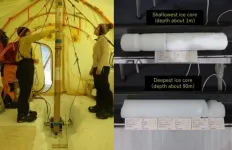Ice core data show why, despite lower sulfur emissions in US and Western Europe, air pollution is dropping more slowly
2021-05-08
(Press-News.org) The air in the United States and Western Europe is much cleaner than even a decade ago. Low-sulfur gasoline standards and regulations on power plants have successfully cut sulfate concentrations in the air, reducing the fine particulate matter that harms human health and cleaning up the environmental hazard of acid rain.
Despite these successes, sulfate levels in the atmosphere have declined more slowly than sulfur dioxide emissions, especially in wintertime. This unexpected phenomenon suggests sulfur dioxide emission reductions are less efficient than expected for cutting sulfate aerosols. A new study led by Tokyo Institute of Technology (Tokyo Tech), Hokkaido University and the University of Washington explains why.
The open-access paper was published on May 5 in Science Advances.
When concentrations of acidic sulfate from fossil fuel emissions decrease while the concentration of more basic ammonium molecules in the atmosphere stay constant, liquid water droplets in clouds become less acidic. This makes conversion of sulfur dioxide to sulfate more efficient. So, even though air quality regulations have reduced the supply of sulfur dioxide from power plants and shipping, the total amount of sulfate particulates that harm human health has dropped more slowly.
"This does not mean that the emissions reductions aren't working. It's just that there is a reaction which partially mitigates the reductions," said co-author Becky Alexander, a UW professor of atmospheric sciences. "We need to understand this multiphase chemistry in the atmosphere to design an efficient strategy to manage air pollution and accurately predict future air pollution and climate change impacts."
During most of the 20th century, sulfur dioxide emissions increased with industrialization in many parts of the world. But recently that trend has reversed in response to regulations, while ammonium emissions from animals and agriculture continue at the same rate. These trends are expected to continue.
Data from an ice core in Greenland that preserves past years' atmospheres show that the proportion of sulfate containing oxygen with one extra neutron, or oxygen-17, increased in the 1980s after countries began to regulate emissions. The authors' analysis shows this is due to faster sulfate formation in the liquid phase in the atmosphere, which occurs largely within clouds, under less-acidic conditions.
"After the SO2 emission control, relatively lower atmospheric acidity promotes the efficiency of sulfate production in the atmosphere, which weakens the response of sulfate level to the SO2 reduction," said lead author Shohei Hattori at Tokyo Tech. "Our unique isotopic techniques applied for the Greenland ice core records identify the key process of the weakened response of sulfate to SO2 emissions reduction."
The data came from an ice core drilled in southeast Greenland (SE-Dome) as part of a project led by Hokkaido University. The oxygen trapped in this ice provided evidence of sulfate composition from 1959 to 2015, without contamination from local pollution.
"Based on a continuous and high-resolution ice core record from SE-Dome, we could obtain reliable records for atmospheric aerosols without second modification after deposition," said co-author and leader of SE-Dome ice core project Yoshinori Iizuka at Hokkaido University. "We plan to drill a second ice core at the same location this year, and try to reconstruct the aerosol history back to the 1750s."
The ice core does not contain separate data for summer and winter, but models show that other, gas-phase chemical reactions for sulfur dioxide become more important in summer, reducing the summertime impact of changing cloud acidity. Knowing how these molecules react will help improve the atmospheric models used to forecast air quality and project climate change.
INFORMATION:
[Attachments] See images for this press release:

ELSE PRESS RELEASES FROM THIS DATE:
2021-05-08
The use of non-steroidal anti-inflammatory drugs (NSAIDs), such as ibuprofen, does not lead to higher rates of death or severe disease in patients who are hospitalised with COVID-19, according to a new observational study of more than 72,000 people in the UK published in The Lancet Rheumatology journal.
NSAIDs are common treatments for acute pain and rheumatological diseases such as rheumatoid arthritis and osteoarthrosis. Early in the pandemic, there was debate on whether the use of such drugs increased the severity of COVID-19, which led to urgent calls for investigations between NSAIDs and COVID-19.
The ISARIC CCP-UK (International Severe Acute Respiratory and emerging ...
2021-05-07
The most comprehensive study of the family tree for legumes, the plant family that includes beans, soybeans, peanuts, and many other economically important crop plants, reveals a history of whole-genome duplications. The study also helps to uncover the evolution of genes involved in nitrogen fixation--a key trait likely important in the evolutionary spread and diversification of legumes and vital for their use as "green manure" in agriculture. To reconstruct the family tree, researchers compared the DNA sequence of more than 1500 genes from 463 different legume species, including 391 newly sequenced species, that span the diversity of this large plant family.
A paper describing the ...
2021-05-07
With the COVID-19 vaccines on many people's minds, some may be surprised to learn that we do not yet have vaccines for many common infectious diseases.
Take salmonella, for example, which can infect people through contaminated food, water and animals. According to the World Health Organization, non-typhoidal salmonella infection affects more than 95 million people globally each year, leading to an estimated 2 million deaths annually. There is no approved vaccine for salmonella in humans, and some strains are antibiotic-resistant.
But just as scientists spent decades doing the ...
2021-05-07
For some people, social gatherings can be a time to imbibe. And for some, that can turn into a time to overindulge. But how do your neighborhood and your social network affect binge drinking?
Along with colleagues at the RAND corporation in Santa Monica, Indiana University researcher Hank Green examined how neighborhood and social network characteristics were related to adult binge drinking. He and his co-authors found that both factors play a role in how much someone drinks, information that can help us better understand binge drinking among adults.
The study was published in the journal Health and Place, indexed in Science Direct and PubMed.
"Adults living ...
2021-05-07
EUGENE, Ore. -- May 7, 2021 -- Long-running archaeological research, boosted by airborne lidar sensing and machine-learning algorithms, finds that Cambodia's Greater Angkor region was home to 700,000-900,000 people.
The sprawling city, which thrived from the 9th to 15th centuries, has slowly revealed its forest-hidden past to archaeologists, but its total population has been a mystery.
The new estimate, made possible by a study designed at the University of Oregon, is the first for the entire 3,000-square-kilometer mix of urban and rural landscape. The findings published May 7 in the journal ...
2021-05-07
The protein, known as NusG, pauses the transcription machinery at specific DNA sequences to facilitate what is called "intrinsic termination" and prevent unwanted transcription that could disrupt cellular function.
A new study, led by Penn State researchers, shows that NusG and the related protein, NusA, together facilitate termination at about 88% of the intrinsic terminators in the bacteria Bacillus subtilis. Understanding this process expands our basic knowledge of this key cellular function and could eventually aid in the development of antibiotics that target and disrupt gene regulation ...
2021-05-07
Boston, Mass. – Sleep disorders are associated with significantly higher rates of health care utilization, conservatively placing an additional $94.9 billion in costs each year to the United States health care system, according to a new study from researchers at Mass Eye and Ear, a member hospital of Mass General Brigham.
In their new analysis, published in the Journal of Clinical Sleep Medicine, the researchers found the number of medical visits and prescriptions filled were nearly doubled in people with sleep disorders such as sleep apnea and insomnia, compared to similar people without. Affected patients were also more likely to visit the emergency department and have more comorbid medical ...
2021-05-07
(Toronto, Friday, May 7, 2021) -- Probing the unique biology of human pancreatic cancer cells in a laboratory has yielded unexpected insights of a weakness that can be used against the cells to kill them.
Led by Princess Margaret Cancer Centre (PM) Scientist Dr. Marianne Koritzinsky, researchers showed that about half of patient-derived pancreatic cancer cell lines are highly dependent or "addicted" to the protein peroxiredoxin 4 (PRDX4), as a result of the altered metabolic state of the cancer cell.
This addiction is vital for the cancer cell's survival, thereby also making it a precise, potential target against the cancer.
Pancreatic cancer is a deadly disease with an overall five-year survival of only eight per cent. Moreover, 36% to 46% of patients who undergo surgery with ...
2021-05-07
Induced bank filtration is a key and well-established approach to provide drinking water supply to populated areas located along rivers or lakes and with limited access to groundwater resources. It is employed in several countries worldwide, with notable examples in Europe, the United States, and parts of Africa. Contamination of surface waters poses a serious threat to attaining drinking water standards. In this context, human pathogenic microorganisms such as some viruses and bacteria, originating from the discharge of wastewater treatment plants, form a major contaminant group. A detailed study at an induced bank filtration site along the Rhine river in Germany has now linked transport of bacteria to seasonal dynamics. Key results of the study show that floods should be ...
2021-05-07
WASHINGTON, D.C. - Peer reviewed by medical experts that included three U.S. government senior scientists and published in the American Journal of Therapeutics, the research is the most comprehensive review of the available data taken from clinical, in vitro, animal, and real-world studies. Led by the Front Line COVID-19 Critical Care Alliance (FLCCC), a group of medical and scientific experts reviewed published peer-reviewed studies, manuscripts, expert meta-analyses, and epidemiological analyses of regions with ivermectin distribution efforts all showing that ...
LAST 30 PRESS RELEASES:
[Press-News.org] Ice core data show why, despite lower sulfur emissions in US and Western Europe, air pollution is dropping more slowly





